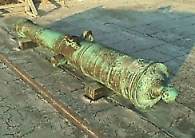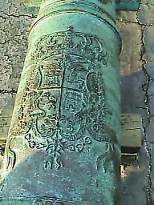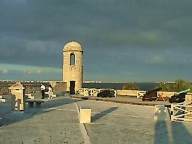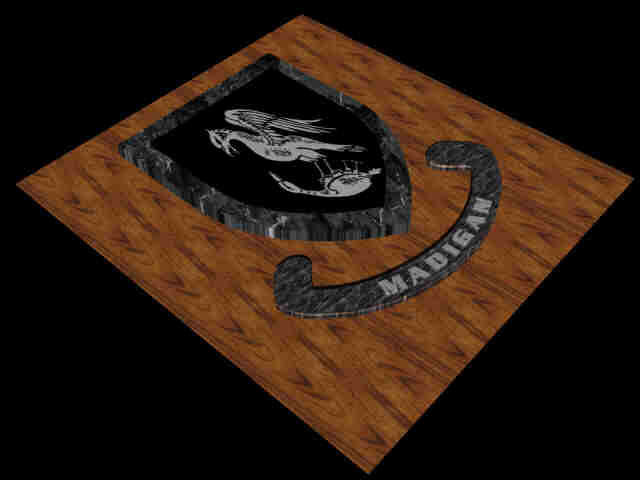The  Castillo's baptism of fire came in 1702 during the
War of the Spanish Succession when the English occupied St.
Augustine and unsuccessfully besieged the fort for 50 days. The
English burned the town before they left, but the Castillo
emerged unscathed, thereby making it a symbolic link between the
old St. Augustine of 1565 and the new city that rose out of the
ashes. To strengthen the defenses, the Spanish erected new
earthwork lines on the north and west sides of St. Augustine,
thus making it a walled city. Matanzas Inlet, however
Castillo's baptism of fire came in 1702 during the
War of the Spanish Succession when the English occupied St.
Augustine and unsuccessfully besieged the fort for 50 days. The
English burned the town before they left, but the Castillo
emerged unscathed, thereby making it a symbolic link between the
old St. Augustine of 1565 and the new city that rose out of the
ashes. To strengthen the defenses, the Spanish erected new
earthwork lines on the north and west sides of St. Augustine,
thus making it a walled city. Matanzas Inlet, however  was still
unfortified when Gen. James Oglethorpe's British troops from Fort
Frederica, in Georgia, attacked St. Augustine in 1740. Again, the
Castillo was besieged and Matanzas Inlet blockaded. But the
Spanish did not waiver during the 27 day British bombardment. The
attack also taught the Spanish the strategic value of Matanzas
Inlet and the need for a strong outpost there. Consequently in
1742 they completed the present coquina tower. We wandered up
onto the bastions to catch a view of the sea and the city. The
old Spanish cannons stood as silent sentries to a time gone by.
As storm clouds built in the east, we gazed out from the watch
tower used to set off the alarm when danger approached. Although
never taken in battle, the Fort changed hands many times. In
1763, following the
was still
unfortified when Gen. James Oglethorpe's British troops from Fort
Frederica, in Georgia, attacked St. Augustine in 1740. Again, the
Castillo was besieged and Matanzas Inlet blockaded. But the
Spanish did not waiver during the 27 day British bombardment. The
attack also taught the Spanish the strategic value of Matanzas
Inlet and the need for a strong outpost there. Consequently in
1742 they completed the present coquina tower. We wandered up
onto the bastions to catch a view of the sea and the city. The
old Spanish cannons stood as silent sentries to a time gone by.
As storm clouds built in the east, we gazed out from the watch
tower used to set off the alarm when danger approached. Although
never taken in battle, the Fort changed hands many times. In
1763, following the  French and Indian War, the British gained control of
Florida from Spain by treaty. Unfortunately the British did not
have enough room to house all their troops in the Fort. They
solved the problem by adding second floors in the Castillo. As we
went through the other casemates (rooms), we could look up along
the walls and see the evidence of the second floors. The Soldier
on the stairs is a member of the 60th Royal American unit, who
occupied the Fort during the American Revolution from 1776 to
1782. This regiment was made up primarily of Americans loyal to
the British Crown
French and Indian War, the British gained control of
Florida from Spain by treaty. Unfortunately the British did not
have enough room to house all their troops in the Fort. They
solved the problem by adding second floors in the Castillo. As we
went through the other casemates (rooms), we could look up along
the walls and see the evidence of the second floors. The Soldier
on the stairs is a member of the 60th Royal American unit, who
occupied the Fort during the American Revolution from 1776 to
1782. This regiment was made up primarily of Americans loyal to
the British Crown . At the
end of the Revolutionary War, in 1783, the 2nd Treaty of Paris
once again gave Spain control of Florida and the Castillo. By
1825, tensions between the U. S. and Spain led to Spain ceding
all of Florida to the United States. The Fort was renamed Fort
Marion. In 1832 a federal policy designed to remove Indians from
all lands east of the Mississippi, was initiated in order to make
way for a white expansion in the area. Most Seminoles refused to
be moved to the "Indian Territory". In 1835
. At the
end of the Revolutionary War, in 1783, the 2nd Treaty of Paris
once again gave Spain control of Florida and the Castillo. By
1825, tensions between the U. S. and Spain led to Spain ceding
all of Florida to the United States. The Fort was renamed Fort
Marion. In 1832 a federal policy designed to remove Indians from
all lands east of the Mississippi, was initiated in order to make
way for a white expansion in the area. Most Seminoles refused to
be moved to the "Indian Territory". In 1835 guerrilla fighting
broke out. The next seven years proved to be the most costly
Indian war ever fought by the United States Army. Osceola, a war
leader, was arrested under a flag of truce just south of St.
Augustine in October 1837. He and 203 Seminoles were imprisoned
at Fort Marion for two months. In late November 1837 twenty
Indians lead by Wildcat and John Cavallo escaped from the Fort
and fled south to the Everglades. In December, Osceola and the
other prisoners were transferred to Fort Moultrie at Charleston,
South Carolina. Osceola died there of an infection in January
1838. Only about 200 Seminoles remained hidden in south Florida
at the end of the Seminole wars. The Fort would continue to serve
as a federal prison, first housing western Indians, and then the
prisoners from the Spanish-American war until it was closed. In
1924, the Fort was proclaimed a national monument and in 1933 the
War Department transferred the property to the National Park
Service. In 1942 the Park Service reinstated the original name of
Castillo de San Marcos.
guerrilla fighting
broke out. The next seven years proved to be the most costly
Indian war ever fought by the United States Army. Osceola, a war
leader, was arrested under a flag of truce just south of St.
Augustine in October 1837. He and 203 Seminoles were imprisoned
at Fort Marion for two months. In late November 1837 twenty
Indians lead by Wildcat and John Cavallo escaped from the Fort
and fled south to the Everglades. In December, Osceola and the
other prisoners were transferred to Fort Moultrie at Charleston,
South Carolina. Osceola died there of an infection in January
1838. Only about 200 Seminoles remained hidden in south Florida
at the end of the Seminole wars. The Fort would continue to serve
as a federal prison, first housing western Indians, and then the
prisoners from the Spanish-American war until it was closed. In
1924, the Fort was proclaimed a national monument and in 1933 the
War Department transferred the property to the National Park
Service. In 1942 the Park Service reinstated the original name of
Castillo de San Marcos.
On Saturday, the City celebrated the annual re-enactment of the
1702 attack on the Fort by the British. We gathered on the south
lawn and around the visitors center waiting for the signal by
cannon that the British had arrived. With the signal, the crowd  was ushered into
the Fort, by Spanish guardsmen, much as happened years ago, and a
musket and cannon battle ensured. We remained outside in the line
of fire. In the past, I have often stood off to the side and
watched as cannon versus cannon fired before us. This can be
quite loud but nothing compared to the sound of a large cannon
fired directly at you. The enactment took place after dark
creating a cascade of lights from musket and cannon. It was a
different kind of experience. This Fort is a treasure and is
carefully and painstakingly preserved and presented as it would
have appeared. Hats off to the National Park Service for a job
well done.
was ushered into
the Fort, by Spanish guardsmen, much as happened years ago, and a
musket and cannon battle ensured. We remained outside in the line
of fire. In the past, I have often stood off to the side and
watched as cannon versus cannon fired before us. This can be
quite loud but nothing compared to the sound of a large cannon
fired directly at you. The enactment took place after dark
creating a cascade of lights from musket and cannon. It was a
different kind of experience. This Fort is a treasure and is
carefully and painstakingly preserved and presented as it would
have appeared. Hats off to the National Park Service for a job
well done.
*** THE END ***

